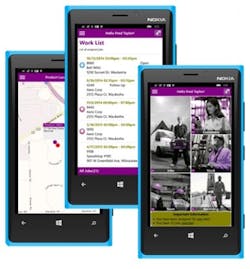Increasing Margin on Aftermarket Field Service Work
Manufacturers and distributors have found for years that margins on goods sold have been tightening as products become commoditized in a global market. Increasingly universal focus on product design (or unauthorized duplication) and greater consistency of initial quality mean it is harder to differentiate on these valued product characteristics.
More manufacturers are therefore focusing on aftermarket service as a way to add value to their offering, drive new revenue or replace flagging revenue from products.
According to a 2013 IDC study, North American equipment manufacturers need to maximize aftermarket service revenue — because without it only 9% were expecting increased revenues in coming years compared to 15% globally. Moreover, aftermarket service is less cyclical than new equipment sales, particularly for heavy equipment that might have a long lifecycle after the sale. This makes aftermarket service more recession-proof and less vulnerable to hiccups as sales of capital equipment or durable goods pushes from one quarter to the next.
In industries where your customers are also working to increase margin or conserve operating revenue, more intelligent aftermarket service might be required because of customer price sensitivity. World-class field service management software could be the difference between being able to sell a service contract and execute against it profitably or letting customers run equipment to failure.
Field service management software, reverse logistics software, route and schedule optimization — all play a role in ensuring aftermarket service work can be performed profitably. Here are several factors manufacturing executives and others involved in aftermarket service should consider to ensure their enterprise systems will help them deliver service profitably.
Counterintuitive Usability Metrics
Applications used to facilitate aftermarket service in the field, however, are designed around process flows that limit the time a technician needs to spend interacting with the application. Even with little manual interaction with the application, the technician can still record the completion of work, request spare parts in inventory or seek guidance from remote subject matter experts when necessary. They may also be able to communicate with a customer with a simple tap on a wearable device as they depart for the job, so the customer knows they are coming, tapping again to let them know they have arrived.
Knowledge Capture, Hiring and Retention
A number of industrial sectors, including power generation, utilities, and other asset- and service-intensive industries, are seeing their skilled workforces nearing or cresting retirement age. They are scrambling to replace not only the headcount of their retiring workers but to retain the latent knowledge these individuals have accumulated. According to a 2015 study conducted by the Service Council, 46% of organizations said they had unfilled vacancies for field service technicians. Skilled workers retire or leave as an improving economy creates new opportunities. They take their years of experience and insight into troubleshooting, customer equipment and successful repair processes with them. That is one problem that can be detrimental to profitable delivery of aftermarket service.
Knowledge capture tools built into a field service software system will allow technicians to view tutorials or videos, either in a field or in a depot repair environment, to guide them through key processes or to solve challenging issues. This can increase first time fix rates and reduce time-on-site, which reduces cost of service provision while also ensuring customer satisfaction and SLA compliance. It can also be a force multiplier, taking the knowledge of your most skilled employees and extending it across more workers or even retaining knowledge of retired or departed workers.
Replacing these workers with millennials and other younger workers will also be easier if the hardware and software solutions are equal to or at least comparable in usability to the tools digital natives have grown up with. An IFS study of manufacturing executives found that many tend to use Microsoft Excel rather than their enterprise software system of record because the enterprise functionality is so hard to use or understand. In the study, younger manufacturing professionals were less likely than their older, more seasoned peers to speak up about poor usability. Rather, 70% of respondents aged 18-35 would look for a different job if they were forced to use poorly designed, hard to use enterprise technology.
Reverse Logistics
Regardless of whether you call it reverse logistics, aftermarket logistics or the reverse supply chain, many aftermarket service organizations need to plan for products, parts or subcomponents to be taken from a customer site back into inventory. These items may be repaired on site and returned to the customer, sent back to a supplier for credit against an account or disposed of. Regardless, a lack of sound reverse logistics software functionality can drive non-value-added cost and harm the customer experience.
Several types of functionality are required to successfully and profitably handle reverse logistics including:
- Return for Repair, which will handle shipping of a product, part or subcomponent to a designated repair center so the specific item can be returned to the original customer once it has been repaired. Lacking appropriate software functionality, an aftermarket service department may struggle to achieve timely returns due to long repair turnaround time or repair part shortages.
- Return then Swap, a transaction where the unusable product or part is shipped to a designated repair location, found to be non-repairable and then “swapped” for a new item, which is then returned to the customer. Lacking suitable software functionality, an aftermarket service team can stumble as they find replacement inventory is not available, the ownership of the part is hard to determine or they are unable to determine if parts are in or out of warranty.
- Advance Exchange, a challenging and complex transaction where a new or refurbished product or part is shipped to the customer to replace an unusable product or part, which the customer returns after receipt of the new or refurbished item. This can be difficult to manage because of inventory availability issues, billing and follow-up required to ensure defective items are in fact returned. This transaction must also often be configurable by a customer or partner, as some organizations may be trusted enough to request a replacement prior to return receipt of the old one while others may not.
- Even Return Only transactions can be difficult to manage. When unusable or undesired products or parts are returned without any replacement process, an aftermarket service department can struggle to manage the resulting inventory and may also need to credit accounts of customers in a timely and reliable fashion.
At Least Plan Around IoT
The Internet of Things (IoT) can be relevant to aftermarket service on a number of levels. Automated messages from a technician regarding arrivals and departures can be, through a formal definition, considered an IoT technology.
But IoT can also enable an aftermarket service offering to extend their services beyond break-fix repair or scheduled maintenance to condition-based or predictive maintenance. If a sensor on a compressor detects severe transients that would likely have damaged a valve, a technician may be dispatched without further human intervention and parts automatically ordered. Or, service or maintenance actions may be triggered by any number of performance criteria or a specific number of duty cycles of a piece of equipment has experienced. Armed with this data, service providers can become a more valued and proactive partner with their customers.
In addition to monitoring the performance of individual pieces of equipment, IoT can also collect data about equipment in the aggregate, creating large amounts of information that can be analyzed and modeled. This accumulation of equipment performance and reliability data enables comparisons of individual pieces of equipment with others of the same type, or model. That comparative data can help service providers identify individual units that are operating outside the norm so corrective action can be taken proactively. The accumulation of data also allows engineering, manufacturing and service providers to identify product quality issues, so they can be proactively corrected in future versions of the product, and/or corrected for existing equipment through the creation of field upgrades and engineering changes.
Per-Asset Tracking
Not every software tool sold to an aftermarket service organization will provide extensive support for per-asset tracking. Yet this functionality is essential for a number of industries where traceability is essential for regulatory or other purposes. Per-asset tracking might be essential in a number of situations. A capital asset being serviced — a piece of medical equipment or a transit asset — may require a detailed maintenance history due to the level of mission criticality. But serial tracking of parts and components, the frequency and duration of each service visit, even the qualifications of the technician could be needed for compliance or audit purposes. In some cases, components or subcomponents of a part, lot or batch of consumables used in a service effort or lot or batch of steel, plastic or other material used in part manufacture must also be tracked.
This is best achieved if the solution used for aftermarket service is tightly integrated with the functionality used to manufacture the asset to begin with. This will allow for full asset lifecycle management and traceability of the asset from cradle to grave, which may be required for regulatory or risk management purposes but certainly will allow an aftermarket service team to deepen their relationship with the customer.
IFS Senior Client Manager Christine Lavoi has worked in information technology for more than 25 years, primarily in the field service management space. She holds a B.S. in Business Administration from the University of Wisconsin-La Crosse.


